As much as I like innovative technology, I also have a soft spot for vehicles that keep the driving experience as simple and as pleasurable as possible. Enter the 2016 Mazda3 Sport GS.

First impressions
I spent a week with this popular hatchback, in Meteor Grey Mica. The “Sport” in the vehicle’s name refers to the hatchback. If you prefer your cars with trunks, check out the Mazda3 (sans “Sport” in its name).
Sporty curves sprout from a very vertical front end and lead to the dual sport exhaust and spoiler in the rear. Looking at this vehicle from the front, you don’t mistake the automaker. Mazda applies its Kodo Soul of Motion design ethos consistently across its lineup, and while it varies at the sides and even more at the rear, the front end, with its large front and swept-back headlights, strongly define the brand.
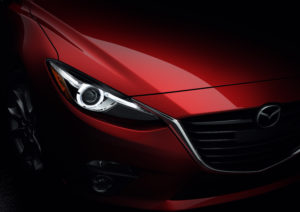
image courtesy Mazda
This may seem tough to do across vehicles the range in size from the petite MX-5 to the CX-9 3-row SUV, but Mazda pulls it off, and each vehicle is more attractive for it.
Interior
I quickly made myself comfortable in high-grade cloth seats using manual adjustments. Even with the moonroof, I could sit up straight and comfortably, not having to incline my head.
Higher-end touches don’t abound in this trim level of the 3, accenting a refined but unremarkable interior. There is leather on the steering wheel, shift knob and brake lever, all of which are subtly highlighted using red stitching. You get heated front seats and heated side mirrors, plus rain-sensing wipers. That’s about the extent of luxury touches, though. You don’t get doors that unlock upon approach. The liftgate doesn’t even get a release button inside the cabin. (I checked where the manual said it should be.)
None of this matters, though… but I’ll get to that later in this post.
Hockey bag test
There’s no problem here. The bag fits in front of the rear seat backs with about six inches to spare between it and the liftgate. The privacy cover closes easily above the bag. The relatively high floor conceals a spare tire and several tools.
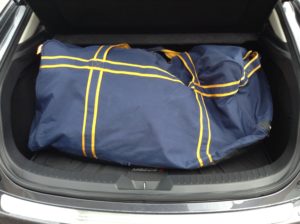
In-car technology
The Mazda3 doesn’t bristle with buttons, sliders and so forth but it doesn’t mean the technology wasn’t included.
Front-seat occupants control the 7” TFT display (what looks like a thick, kid-proof tablet jammed into the centre of the dash) using the HMI commander, a volume knob and five buttons, all of which sit just ahead of the centre armrest/storage compartment.
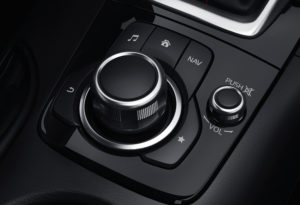
image courtesy Mazda
Thanks in part to this clean look, the Mazda system may boast the most user-friendly in-car infotainment interface design of any major manufacturer. Big, friendly icons on the screen welcome people who press the Home button.
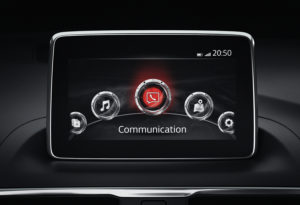
image courtesy Mazda
You scroll through this and other screens using the commander, then pressing the commander to make a selection. You can navigate through any tabs by pressing the commander side to side, like a joystick. Turn the knob, press it down, press it side to side – if one action doesn’t work, another will. And if you go in the wrong direction, there’s always a “back” button to the left of the commander.
There was no navigation system in my tester, but it’s available as a card that goes into a slot by the two USB ports ahead of the shifter, partially hidden in a recessed open storage area big enough to accommodate the most monstrous phones buyers can bring into the vehicle. For more power, there’s an accessory outlet in the centre cubby.
The instrument cluster isn’t overwhelming, and that’s an increasingly rare things to say in today’s vehicles. It consists of a large central speedometer flanked by two screens. The one on the right shows the driver several sets of fuel economy readouts. You can get more detail on fuel economy, including graphics, on the 7” TFT display. I set this display to appear when I turned off the motor – I didn’t want to check while driving.
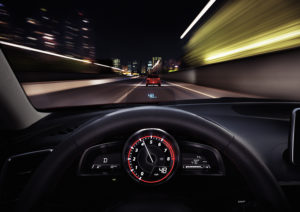
image courtesy Mazda
The screen left of the speedo shows a digital tachometer, something I found displeasing for some reason.
Was it harder to read because it was small? It certainly didn’t match the analog speedometer design, something I’d prefer automakers adopted as a default design decision.
Mazda also offers a “heads-up” display it calls the Active Driving Display. Not included on my tester, this display shows information like that for the optional Radar Cruise Control. (Other carmakers call this adaptive cruise control. It uses front-facing sensors to maintain a set gap between 3 and any vehicle ahead of it while cruising on the highway.)
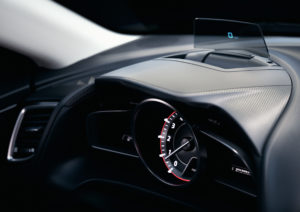
image courtesy Mazda
Climate controls are (blessedly) manual, consisting of three dials several buttons and no screens, as God intended them to be.
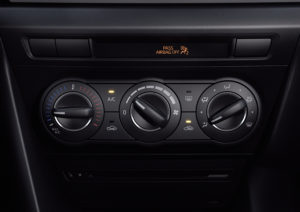
image courtesy Mazda
Mazda does offer a “digital” version, but I don’t see the point.
Driving
I didn’t dwell on the inability to have the vehicle unlock doors when I approached it. I had too much fun putting the SKYACTIV-G 2.0L four-cylinder through its paces. It generates 155 horsepower and 150 lb-ft of torque, so it won’t necessarily sprint past other vehicles off the line, but it does offer a modicum of power when needed. For the “power-hungry” the GT trim ships with a 2.5L engine.
Try the GS with the 6-speed manual transmission. When coupled with the 2-litre, the 3 proved smooth and responsive in all (summertime) conditions. Shifts were short throws, reverse was an easy slide to the left and up, and the shifter just felt right from the time I drove the 3 out of Mazda Canada’s parking lot.
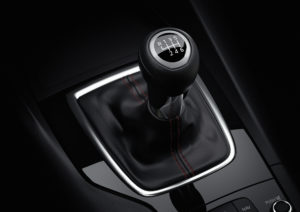
image courtesy Mazda
Mazda also offers a SKYACTIV-Drive-6-speed auto with SPORT mode.
The smooth, confident ride also stemmed from driving technologies like the standard traction control and dynamic stability control. Also standard is Mazda’s i-ELOOP the innovation of bringing regenerative braking technology into a car that doesn’t have an electric engine. The SKYACTIV-G drivetrain takes energy generated during braking (including engine braking) and stores it. That electrical energy runs air conditioning, the radio and other electrical devices, reducing the load on the engine and helping the driver save fuel.
There’s another technology that seemed to lower real-time fuel economy to 0 litres/100 kilometres when I eased off the accelerator while driving on a gentle down slope.
Technology package features include: Smart City Brake Support (Mazda’s form of frontal collision avoidance); Blind Spot Monitoring system; Rear Cross Traffic Alert; Lane Departure Warning System; Anti-theft alarm system; High Beam Control system (to keep from blinding drivers in cars ahead of you); and Adaptive Front-lighting System with automatic levelling, to move the headlights in the direction you turn the steering wheel.
My GS tester didn’t included this package, but Mazda does make it available on higher trim levels.
Fuel economy
Mazda claims 8.2 L/100km in the city and 5.9 L/100km on the highway. I usually managed a combined 6.5 L/100km.
The Mazda3 takes regular fuel in its 50-litre fuel tank
Pricing
The Mazda3 Sport GS I drove retails for $20,850 base MSRP. With options ($900 moonroof), freight and PDE, the total comes to $23,445. (The Mazda3 sedan sells for less.)